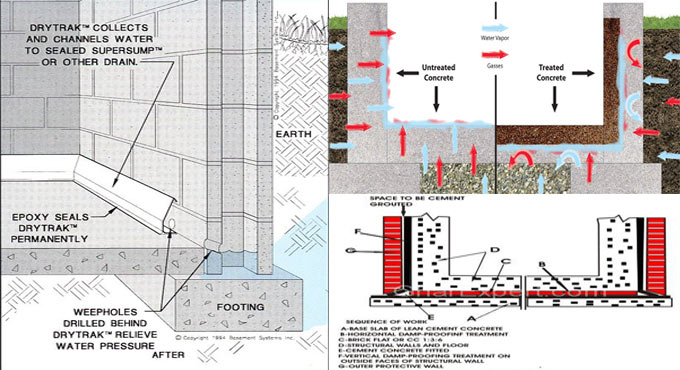
Waterproofing of Concrete, Walls and Floors

Construction of any building is not easy and it doesn?t end after completing the building; as there are so many other little things that need to look after before making a building.
One of those is waterproofing the building, a building must be guarded from water, heat, heavy sunrays and dust; if any of them is not properly followed during the construction then the building is not safe actually. Waterproofing is done at the time of concrete and sometimes a badly made concrete can?t guard the building from water for the discrimination of water by any admixtures.
A concrete is called waterproof when a dense concrete is made with right amount of total non-porous material and low water ratio; which will create a minimum of air blanks. As all concretes are porous so these holes need to be reduced for making the concrete so far tight to water.
It is sometime good to use a little extreme proportion of fines to make a good concrete; also a little increment in cement content over normal concrete is also beneficial as more cement needs less water for the same amount of work.
This thing need to describe a little more, here some methods is discussed for waterproofing:
a) Concrete and masonry grains are made waterproof with the use of three substitute layers of alum and soap mixtures, at first a hot alum solution is prepared with hot water, applied and worked in with a firm brush after pouring the hot soap mixture. The solutions are used with a gap of about 24 hours between the alternate coats; soap mixtures act like lubricants and also form difficult fillers by response with cement and may be applied while the concrete remains green.
b) When a fully hydrated white lime is added with the following mixtures it gives more proof from water; this mixture acts good as the lime paste absorbs about double the volume of paste when it mixed with equal weight of cement. It is also very effective in faulty filing but the mixture should be of thick concrete; the hydrated lime actually grows ability of work that gives a slight decrease in water content and reduces penetrability. Concrete must be made rich where the excess cement should be 15-20% over sand and 20% excess mortar over rough aggregate; a ratio mixture of 1:1.5:3 with water/cement ratio of about 0.40 will make the concrete really water-proof.
c) After the practicable work, the form-work has to be removed and the concrete exterior should be rubbed smooth and washed. To fill the holes, a mixture of cement and sand in the ratio of 1:1.5 with water-proofing compound is applied over the whole exterior without leaving any material on the concrete face.
d) Work on concrete floors are done at the time of cementing with dry cement which is sprayed over the exterior and worked in with a steel trowel on the first set of the concrete.
e) The method of water-proofing on the surfaces depend on the quality of concrete and the smallest holes can be filled with slit or fine clay, boiled linseed oil, paraffin or varnish then brushed over the exterior after the concrete has dried well. Nearly two or three layers are applied and dried before the next application; one or two layer of coal tar makes the exterior waterproof, concrete must be dry and free of dust and a thin bituminous coat can also be given for more firmness.
f) Generally Bituminous Putties are laid on horizontal exteriors and also mopped on vertical exteriors when they are either hot or cold.
g) Proprietary compounds like Pudlo, Medusa etc. are used as per the instructions of manufacturers. Insert materials which are of the finest particles can be used to dense the concrete especially when the total is in fines.
h) Silicate or soda also works well in water-proofing; whereas the mixture of 1 kg of washing soda and water will make a cement mortar water-proof.


